|
|
|
Sort Order |
|
|
|
Items / Page
|
|
|
|
|
|
|
| Srl | Item |
| 1 |
ID:
104884
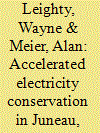

|
|
|
|
|
| Publication |
2011.
|
| Summary/Abstract |
An avalanche destroyed the main hydroelectric transmission line to Juneau, Alaska in April, 2008. Diesel-generated electricity was substituted, causing electricity prices to increase 500% for 45 days. Electricity demand fell by 25% during the supply disruption. Most of the reduction occurred before the higher rates were implemented. Some conservation - about 8% of historic consumption - persisted after the transmission line was repaired and prices returned to normal. Consumers reduced energy use through a combination of new habits and technical improvements. A survey of residential consumers indicated that the average household undertook 10 conservation actions, with major changes in lighting, space heating, fuel switching, and water and appliance use. We propose a method for prioritizing conservation actions for promotion according to their impact in electricity savings (as a function of popularity, effectiveness, and persistence) and a dynamic framework for electricity use before, during, and after a supply disruption (i.e., both the magnitude and rates of change in electricity conservation).
|
|
|
|
|
|
|
|
|
|
|
|
|
|
|
|
| 2 |
ID:
104943


|
|
|
|
|
| Publication |
2011.
|
| Summary/Abstract |
The electricity reforms were initiated in India with the objective of promoting competition in the electricity market. In order to promote competition, the Electricity Act 2003 was enacted and various policy initiatives were taken by the Government of India. Central Electricity Regulatory Commission (CERC) also facilitated competition through the regulatory framework of availability based tariff, Indian Electricity Grid Code, open access in inter-state transmission, inter-state trading and power exchanges. Despite these initiatives, electricity prices increased in the Wholesale Electricity Market in India (WEMI). This paper analyses the market structure and competitiveness in the WEMI. There are, of course, various potential reasons for the rise in the electricity price. This paper seeks to investigate, if market power was one of the reasons for increase in market prices. Concentration ratio, Herfindahl-Hirschman index, Supply Margin Assessment, and Residual Supply Index have been used to measure market power. This paper also uses the price-cost mark-up to examine, if exercise of market power led to higher margins. The analysis suggests that market power of firms may be part of the reason for the increase in electricity prices in WEMI. The study suggests various measures to increase competition in the WEMI.
|
|
|
|
|
|
|
|
|
|
|
|
|
|
|
|
| 3 |
ID:
104887
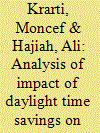

|
|
|
|
|
| Publication |
2011.
|
| Summary/Abstract |
In this paper, a detailed simulation-based analysis is conducted to assess the impact of adopting Daylight Saving Time (DST) on the electrical energy use and peak demand in Kuwait. The analysis focused on the impact of DST in the building sector since it represents 90% of electrical energy usage of Kuwait.
The simulation results indicate that the adoption of DST has mixed impacts for Kuwait. While the commercial and the governmental sectors may benefit from the DST, the private residences and apartment buildings can see both their annual energy use and peak demand increase slightly by adopting DST. The overall impact of the DST implementation is rather minimal with a slight increase energy use of about 0.07% and a slight reduction in peak demand of 0.14% or about 12 MW based on 2005 electrical peak demand for Kuwait.
|
|
|
|
|
|
|
|
|
|
|
|
|
|
|
|
| 4 |
ID:
104901
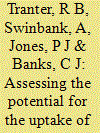

|
|
|
|
|
| Publication |
2011.
|
| Summary/Abstract |
We report on an assessment of the potential for energy production from on-farm anaerobic digestion (AD) in England based on findings from a survey of farmers where it was found that around 40% of 381 respondents might install AD on their farms. These 'possible adopters' tended to have large farms and might together utilise some 6560 ha of land for feedstock production along with the wastes from some 12,000 beef and dairy cattle and 9000 pigs. When raised to the national level, such a level of AD activity would produce around 3.5 GWh of electricity. This approximates to just 0.001% of national electricity generation. Further, there are considerable perceived barriers to the widespread adoption of AD on farms in England; these include the high capital costs of installing AD and doubts about the economic returns being high enough.
|
|
|
|
|
|
|
|
|
|
|
|
|
|
|
|
| 5 |
ID:
104970


|
|
|
|
|
| Publication |
2011.
|
| Summary/Abstract |
China made a commitment in Copenhagen to reduce its carbon dioxide emissions per unit of GDP from 40% to 45% compared with the 2005 level by 2020, and is determined to vigorously develop non-fossil fuels. This study analyzes the effects and impacts of policies that could help to achieve China's Copenhagen commitments with a hybrid static CGE model in which the electricity sector is disaggregated into 12 generation technologies. Four scenarios are developed, including the reference scenario A, the reference scenario B and two carbon constraint scenarios. The results show that carbon intensity in terms of GDP will fall by 30.97% between 2005 and 2020 in the reference scenario A, and will be reduced further by 7.97% if China's targeted non-fossil energy development plans can be achieved in the reference scenario B. However, the rest of the 40-45% target must be realized by other measures such as carbon constraint. It is also observed that due to carbon intensity constraints, GDP loss would be from 0.032% to 0.24% compared to the reference scenario B, and CO2 emission reductions are due mainly to decreases in coal consumption in the electricity sector and manufacturing sector.
|
|
|
|
|
|
|
|
|
|
|
|
|
|
|
|
| 6 |
ID:
104878


|
|
|
|
|
| Publication |
2011.
|
| Summary/Abstract |
Latest estimates suggest that widespread deployment of carbon capture and storage (CCS) could account for up to one-fifth of the needed global reduction in CO2 emissions by 2050. Governments are attempting to stimulate investments in CCS technology both directly through subsidizing demonstration projects, and indirectly through developing price incentives in carbon markets. Yet, corporate decision-makers are finding CCS investments challenging. Common explanations for delay in corporate CCS investments include operational concerns such as the high cost of capture technologies, technological uncertainties in integrated CCS systems and underdeveloped regulatory and liability regimes. In this paper, we place corporate CCS adoption decisions within a technology strategy perspective. We diagnose four underlying characteristics of the strategic CCS technology adoption decision that present unusual challenges for decision-makers: such investments are precautionary, sustaining, cumulative and situated. Understanding CCS as a corporate technology strategy challenge can help us move beyond the usual list of operational barriers to CCS and make public policy recommendations to help overcome them.
|
|
|
|
|
|
|
|
|
|
|
|
|
|
|
|
| 7 |
ID:
104929
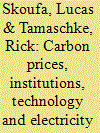

|
|
|
|
|
| Publication |
2011.
|
| Summary/Abstract |
A relationship exists for the liberalised Australian electricity supply industry between institutional structures and technological change. The traditional institutional framework has been based on centralised generation and a regulated vertically integrated monopoly structure. This paper investigates the issues of institutional and technological change using the social cost perspective (including externalities), and focuses on the imperatives of greenhouse gas emission reductions.
An Australian context has been chosen for the paper, in light of a proposed price on carbon; be that via an emission trading scheme or carbon tax. The power generation sector is dominated by coal- and gas-fired power plants due to the large reserves of coal and gas available in Australia. If carbon pricing of up to AU$40/tCO2 is introduced then the merit order for dispatch changes but coal-fired power generation sources remain an option.
|
|
|
|
|
|
|
|
|
|
|
|
|
|
|
|
| 8 |
ID:
104969


|
|
|
|
|
| Publication |
2011.
|
| Summary/Abstract |
Assessments of the impact of electrification on the quality of life of households in developing countries have increased over the last decade. One aspect that has still received little attention is education and the ability of children to keep up at school. The underlying hypothesis is that electrification enables children to do their homework in the evening and so keep up with their school work. To this first hypothesis we add a second one, concerning the relation between access to electricity and attendance to school according to gender. Although most household tasks are carried out by the mothers, their daughters are also involved, and electrification could have a beneficial effect by making easier for girls to do their homework in the evening and easier for the mothers to help them. We will check the validity of these hypotheses using a case study of 162 children attending school in a small town in northwestern Madagascar.
|
|
|
|
|
|
|
|
|
|
|
|
|
|
|
|
| 9 |
ID:
104896


|
|
|
|
|
| Publication |
2011.
|
| Summary/Abstract |
The global rise of greenhouse gas (GHG) emissions and its potentially devastating consequences require a comprehensive regulatory framework for reducing emissions, including those from the transport sector. Alternative fuels and technologies have been promoted as a means for reducing the carbon intensity of the transport sector. However, the overall transport policy framework in major world economies is geared towards the use of conventional fossil fuels. This paper evaluates the effectiveness and efficiency of current climate policies for road transport that (1) target fuel producers and/or car manufacturers, and (2) influence use of alternative fuels and technologies. With diversifying fuel supply chains, carbon intensity of fuels and energy efficiency of vehicles cannot be regulated by a single instrument. We demonstrate that vehicles are best regulated across all fuels in terms of energy per distance. We conclude that price-based policies and a cap on total emissions are essential for alleviating rebound effects and perverse incentives of fuel efficiency standards and low carbon fuel standards. In tandem with existing policy tools, cap and price signal policies incentivize all emissions reduction options. Design and effects of cap and trade in the transport sector are investigated in the companion article (Flachsland et al., in this issue).
|
|
|
|
|
|
|
|
|
|
|
|
|
|
|
|
| 10 |
ID:
104983
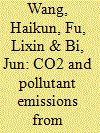

|
|
|
|
|
| Publication |
2011.
|
| Summary/Abstract |
In this paper, CO2 and pollutant emissions of PCs in China from 2000 to 2005 were calculated based on a literature review and measured data. The future trends of PC emissions were also projected under three scenarios to explore the reduction potential of possible policy measures. Estimated baseline emissions of CO, HC, NOx, PM10 and CO2 were respectively 3.16×106, 5.14×105, 3.56×105, 0.83×104 and 9.14×107 tons for China's PCs in 2005 with an uneven distribution among provinces. Under a no improvement (NI) scenario, PC emissions of CO, HC, NOx, PM10 and CO2 in 2020 are respectively estimated to be 4.5, 2.5, 2.5, 7.9 and 8.0 times that of 2005. However, emissions other than CO2 from PCs are estimated to decrease nearly 70% by 2020 compared to NI scenario mainly due to technological improvement linked to the vehicle emissions standards under a recent policy (RP) scenario. Fuel economy (FE) enhancement and the penetration of advanced propulsion/fuel systems could be co-benefit measures to control CO2 and pollutant emissions for the mid and long terms. Significant variations were found in PC emission inventories between different studies primarily due to uncertainties in activity levels and/or emission factors (EF).
|
|
|
|
|
|
|
|
|
|
|
|
|
|
|
|
| 11 |
ID:
104899


|
|
|
|
|
| Publication |
2011.
|
| Summary/Abstract |
Agriculture has an important role in every country's development. Particularly, the contribution of agriculture to development and competitiveness is increasing with agricultural productivity growth. Productivity, in turn, is closely associated with direct and indirect use of energy as an input. Therefore, the importance of energy in agriculture cannot be denied as one of the basic inputs to the economic growth process. Following the importance of energy in Turkish agriculture, this study aims to estimate the long- and short-run relationship of energy consumption, agricultural GDP, and energy prices via co-integration and error correction (ECM) analysis. Annual data from 1970 to 2008 for diesel and electricity consumptions are utilized to estimate long-run and short-run elasticities. According to ECM analysis, for the diesel demand model, the long-run income and price elasticities were calculated as 1.47 and -0.38, respectively. For the electricity demand model, income and price elasticities were calculated at 0.19 and -0.72, respectively, in the long run. Briefly, in Turkey, support for energy use in agriculture should be continued in order to ensure sustainability in agriculture, increase competitiveness in international markets, and balance farmers' income.
|
|
|
|
|
|
|
|
|
|
|
|
|
|
|
|
| 12 |
ID:
104886


|
|
|
|
|
| Publication |
2011.
|
| Summary/Abstract |
Across the United States, universities are grappling with challenges associated with adopting approaches to more sustainable energy use. One approach has been to develop energy-related projects in their local, host communities. Because host communities can play a major role in the successful planning and implementation of these projects, understanding the factors relating to their support is important. Building on research that suggests that procedural fairness is one such key factor, this study examines community members' support of six approaches a local university could implement to work towards a goal of carbon neutrality. The results of a mail survey (N=677) found that perceived fairness of campus decision makers was significantly related to community support for the proposed approaches; however, beliefs about the efficacy of the different approaches to address challenges associated with climate change had the strongest relationship with support. The results also suggest that residents prefer changes in the energy infrastructure, such as the development of wind power, over the purchase of carbon offsets. We discuss the results in terms of actions that universities may take to foster community engagement in decision-making for university-sponsored sustainable energy projects.
|
|
|
|
|
|
|
|
|
|
|
|
|
|
|
|
| 13 |
ID:
104889


|
|
|
|
|
| Publication |
2011.
|
| Summary/Abstract |
In China, coal-fired power plants are the main supplier of electricity, as well as the largest consumer of coal and water resources and the biggest emitter of SOx, NOx, and greenhouse gases (GHGs). Therefore, it is important to establish a scientific, reasonable, and feasible comprehensive evaluation system for coal-fired power plants to guide them in achieving multi-optimisation of their thermal, environmental, and economic performance. This paper proposes a novel comprehensive evaluation method, which is based on a combination of the grey relational analysis (GRA) and the analytic hierarchy process (AHP), to assess the multi-objective performance of power plants. Unlike the traditional evaluation method that uses coal consumption as a basic indicator, the proposed evaluation method also takes water consumption and pollutant emissions as indicators. On the basis of the proposed evaluation method, a case study on typical 600 MW coal-fired power plants is carried out to determine the relevancy rules among factors including the coal consumption, water consumption, pollutant, and GHG emissions of power plants. This research offers new ideas and methods for the comprehensive performance evaluation of complex energy utilisation systems, and is beneficial to the synthesised consideration of resources, economy, and environment factors in system optimising and policy making.
|
|
|
|
|
|
|
|
|
|
|
|
|
|
|
|
| 14 |
ID:
104912
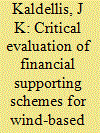

|
|
|
|
|
| Publication |
2011.
|
| Summary/Abstract |
After a long stagnating period during the second half of the 1990s, the market of wind energy in Greece was described by remarkable but unstable growth rates that resulted in the operation of 1 GW of wind power by the end of 2009. Still though, penetration of wind energy is not the one anticipated. On the other hand, national targets regarding the Renewable Energy Sources' (RES) contribution and existence of excellent wind potential areas across Greece challenge new wind energy investments. Acknowledging the unsteady development rates of wind power in Greece, efficiency of the State support mechanisms is currently investigated. Based on an analytical evaluation model, the investigation undertaken is extended to provide a detailed cost-benefit analysis of several wind energy case studies, including mainland and island applications as well as comparison with both conventional power stations and photovoltaic plants. For this purpose, the financial support provided by the State is directly compared with benefits accruing from the operation of wind parks, considering also the avoidance of social costs deriving from thermal power stations. Based on the results obtained, the beneficial characteristics of wind energy applications for the Greek society are clearly demonstrated, especially in the case of non-interconnected island grids.
|
|
|
|
|
|
|
|
|
|
|
|
|
|
|
|
| 15 |
ID:
104905


|
|
|
|
|
| Publication |
2011.
|
| Summary/Abstract |
In this article, we discuss the "cycle hypothesis" in electricity generation, which states that the introduction of deregulation in an electricity system might lead to sustained fluctuations of over- and under-capacity. The occurrence of cycles is one of the major threats for electricity markets as it affects the security of supply, and creates uncertainty in both the profitability of electricity companies and in consumer prices. We discuss the background for these cycles using analogies with other capital-intensive industries, along with evidence from the analysis of behavioral simulation models as well as from experimental electricity markets. Using data from the oldest deregulated markets we find support for the hypothesis in the case of the English and Chilean markets, based on an autocorrelation analysis. Evidence from the Nordpool market is more ambiguous, although we might be observing the first half of a cycle in generation capacity. Comparing a simulation of the English market performed in 1992 with the actual performance we can observe that the qualitative behavior of the model is consistent with the actual evolution. Finally, we discuss possible mechanisms for damping cycles in electricity generation, such as mothballing, capacity payments, and reliability markets.
|
|
|
|
|
|
|
|
|
|
|
|
|
|
|
|
| 16 |
ID:
104975


|
|
|
|
|
| Publication |
2011.
|
| Summary/Abstract |
The utilisation of demand side resources is set to increase over the coming years with the advent of advanced metering infrastructure, home area networks and the promotion of increased energy efficiency. Demand side resources are proposed as an energy resource that, through aggregation, can form part of the power system plant mix and contribute to the flexible operation of a power system. A model for demand side resources is proposed here that captures its key characteristics for commitment and dispatch calculations. The model is tested on the all island Irish power system, and the operation of the model is simulated over one year in both a stochastic and deterministic mode, to illustrate the impact of wind and load uncertainty. The results illustrate that demand side resources can contribute to the efficient, flexible operation of systems with high penetrations of wind by replacing some of the functions of conventional peaking plant. Demand side resources are also shown to be capable of improving the reliability of the system, with reserve capability identified as a key requirement in this respect.
|
|
|
|
|
|
|
|
|
|
|
|
|
|
|
|
| 17 |
ID:
104974


|
|
|
|
|
| Publication |
2011.
|
| Summary/Abstract |
The recent failure of Copenhagen negotiations shows that concrete actions are needed to create the conditions for a consensus over global emission reduction policies. A wide coalition of countries in international climate change agreements could be facilitated by the perceived fairness of rich and poor countries of the abatement sharing at international level. In this paper I use two popular climate change integrated assessment models to investigate the path and decompose components and sources of future inequality in the emissions distribution. Results prove to be consistent with previous empirical studies and robust to model comparison and show that gaps in GDP across world regions will still play a crucial role in explaining different countries contributions to global warming.
|
|
|
|
|
|
|
|
|
|
|
|
|
|
|
|
| 18 |
ID:
104932


|
|
|
|
|
| Publication |
2011.
|
| Summary/Abstract |
Nuclear power and solar photovoltaic energy conversion often compete for policy support that governs economic viability. This paper compares current subsidization of the nuclear industry with providing equivalent support to manufacturing photovoltaic modules. Current U.S. indirect nuclear insurance subsidies are reviewed and the power, energy and financial outcomes of this indirect subsidy are compared to equivalent amounts for indirect subsidies (loan guarantees) for photovoltaic manufacturing using a model that holds economic values constant for clarity. The preliminary analysis indicates that if only this one relatively ignored indirect subsidy for nuclear power was diverted to photovoltaic manufacturing, it would result in more installed power and more energy produced by mid-century. By 2110 cumulative electricity output of solar would provide an additional 48,600 TWh over nuclear worth $5.3 trillion. The results clearly show that not only does the indirect insurance liability subsidy play a significant factor for nuclear industry, but also how the transfer of such an indirect subsidy from the nuclear to photovoltaic industry would result in more energy over the life cycle of the technologies.
|
|
|
|
|
|
|
|
|
|
|
|
|
|
|
|
| 19 |
ID:
104924
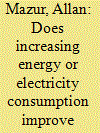

|
|
|
|
|
| Publication |
2011.
|
| Summary/Abstract |
Among the world's nations, per capita energy and electricity consumption is highly correlated with diverse indicators of quality of life. This is often interpreted to mean that additional energy and electricity consumption causes improvements in life quality. Prior analyses of cross-sectional data question this interpretation for industrial nations that already have high per capita energy consumption. The present analysis with longitudinal data shows that among industrial nations, increases in per capita energy and electricity consumption over the past three decades are not associated with corresponding improvements in quality of life.
|
|
|
|
|
|
|
|
|
|
|
|
|
|
|
|
| 20 |
ID:
104965


|
|
|
|
|
| Publication |
2011.
|
| Summary/Abstract |
Chemical reactions and the combustion of dirty fuels, such as coal and petroleum coke (petcoke), that are used in cement production processes generate a significant amount of CO2 emissions. In this paper, we provide an eco-efficiency measure for 21 prototypes of cement industries operating in many countries by applying both a data envelopment analysis (DEA) and a directional distance function approach, which are particularly suitable for models where several production inputs and desirable and undesirable outputs are taken into account. To understand whether this eco-efficiency is due to a rational utilization of inputs or to a real carbon dioxide reduction as a consequence of environmental regulation, we analyze the cases where CO2 emissions can either be considered as an input or as an undesirable output. Empirical results show that countries where cement industries invest in technologically advanced kilns and adopt alternative fuels and raw materials in their production processes are eco-efficient. This gives a comparative advantage to emerging countries, such as India and China, which are incentivized to modernize their production processes.
|
|
|
|
|
|
|
|
|
|
|
|
|
|
|
|
|
|
|
|
|